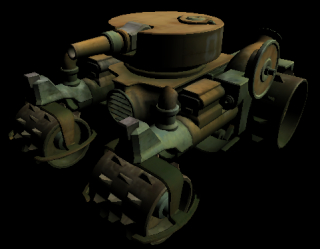
A common dilemma when lighting game objects is how to balance the intensities of ambient vs. directional light. If you choose a low ambient level with bright directional light, you get dramatic, well defined lighting, but the overall result risks being excessively dark, and it can be hard to see any texture detail in the shadowed areas:
If you choose more ambient and less directional light, the whole object is clearly visible, but the lighting risks looking flat and boring:
One useful technique is to give the ambient light a bluish color, while tinting the directional light yellow. This way the lit and shadowed areas can have similar overall brightness, but vary in hue instead. The entire object remains clearly visible, at the same time as the lighting remains well defined:
If you are using a traditional three light rig, where the ambient level is typically very dark or even zero, a similar effect can be achieved by tinting the key light yellow and the back light blue.
This change of hue from light to shadow can be exaggerated for dramatic effect, but also occurs in nature, especially outdoors on a sunny day. The Sun radiates many electromagnetic frequencies, including all possible hues of light, but when this light passes through atmosphere, red and green frequencies are not much affected, while the shorter blue frequencies are absorbed and then re-transmitted by gas molecules, which scatters them in all directions. Therefore: